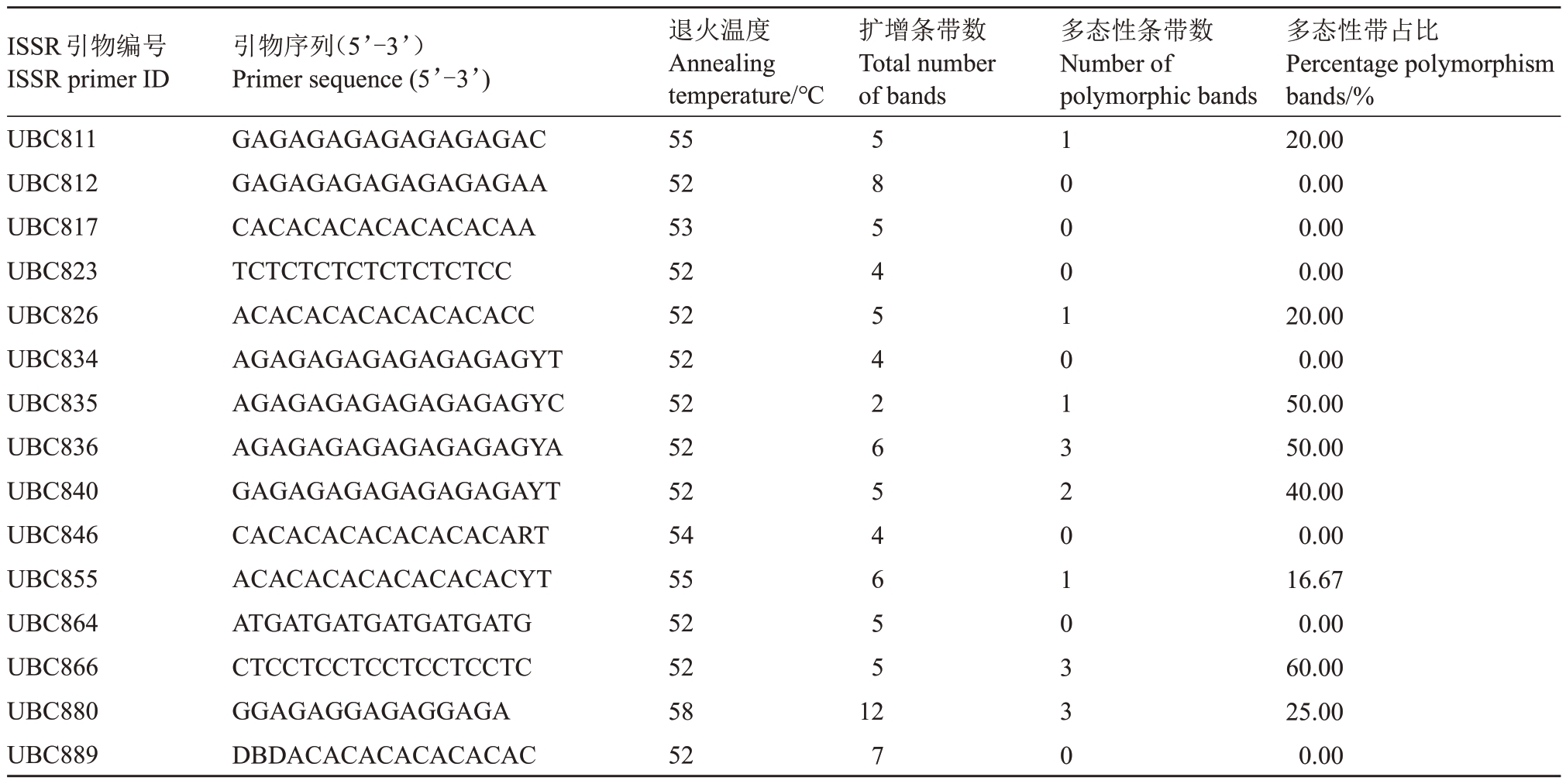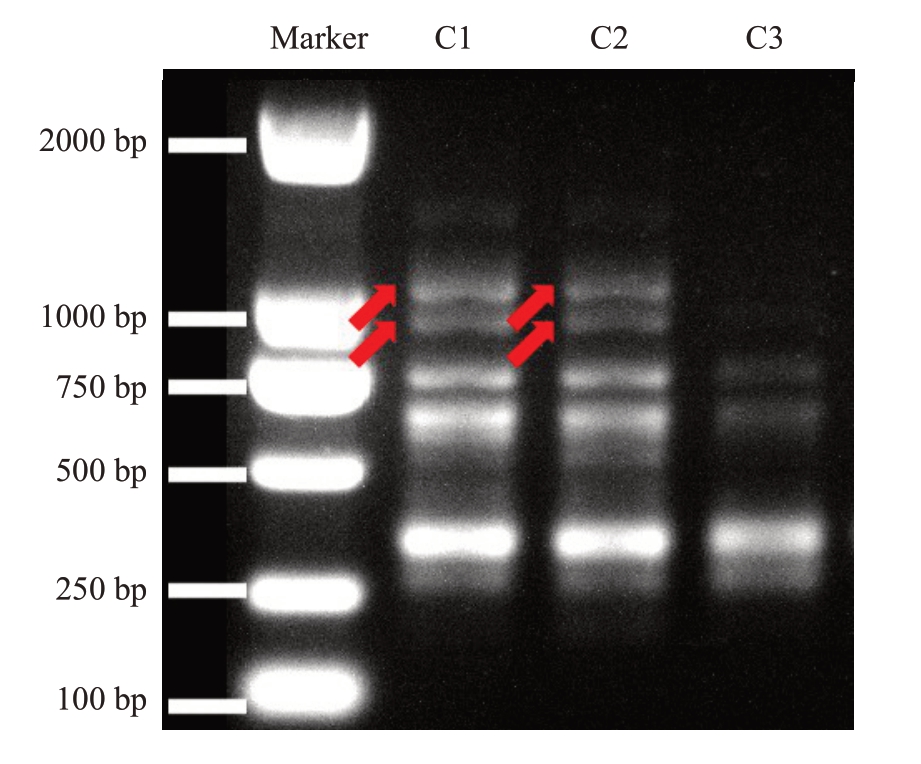桃[Prunus persica(L.)Batsch.]为蔷薇科李属桃亚属落叶果树,是世界上栽培最广泛的蔷薇科果树之一。2021 年福建省桃总产量约16.98 万t,种植面积约为1.21 万hm2 [1]。晚熟桃是果实发育期为121~150 d 的桃品种[2],能够弥补市场夏秋之交及深秋新鲜水果的空缺。1994年,在福建省古田县吉巷乡韦端村定植的颐红桃果园中发现了一株芽变,经过多年观察与统计,该株系表现出了迟熟、果大、可溶性固形物含量较高、丰产等优良性状。通过对果实和其他重要的经济性状进行全面鉴定,优选出晚熟桃优良新品种韦端蜜红。
1 选育过程
1994年,笔者课题组在韦端村定植的颐红品种桃园中发现一株芽变,表现出迟熟、果大、可溶性固形物含量较高、高产、抗逆性较强等优良特性,因此,2000 年在韦端村进行了嫁接鉴定(砧木为2 年生毛桃),嫁接树2002年开始结果。之后,在福建省不同气候区建立多个区试点和核心示范种植基地,系统地开展了生物学特征特性观察、区域生态适应性研究、果实分析鉴评及关键配套栽培技术应用试验等。目前在福建省内区试和推广面积约200 hm2,年产量3000 t左右,促进了福建省桃品种结构的调整,提高了桃栽培的经济效益。2021年12月31日通过了福建省林木品种审定委员会审定,品种名称为韦端蜜红(品种编号:闽S-SV-PP-015-2021,学名:Prunus persica L.Batsch.‘Weiduanmihong’,图1)。韦端蜜红嫁接三代的主要性状比较见表1。
表1 韦端蜜红无性繁殖的性状
Table 1 Characters of the asexual reproduction of Weiduanmihong

户主Farmers果实成熟期Mature period韦日意Wei Riyi吴孝钦Wu Xiaoqin程忠南Cheng Zhongnan嫁接繁殖Propagation by grafting母树Mother tree嫁接一代The first grafting嫁接二代The second grafting树龄Tree age/a 16开花期Period of blooming 02-25—03-15株产量Yield per tree/kg 210.80单果质量Average mass of single fruit/g 260可食率Edible rate/%93.00 w(可溶性固形物)Total soluble solid content/%10.60 12 02-26—03-14 106.00 190 94.15 11.53 8 02-23—03-20 7月下旬至8月上旬Late Jul.to early Aug.7月下旬至8月上旬Late Jul.to early Aug.7月下旬至8月上旬Late Jul.to early Aug.89.57 259 93.73 11.89落叶期Defoliating period 11月下旬Late Nov.11月下旬Late Nov.12月上旬Early Dec.

图1 韦端蜜红桃果实及其成年树
Fig.1 Peach fruit and adult trees of Weiduanmihong
2 主要性状
2.1 植物学特征
韦端蜜红树势中等,树姿开张,幼龄树枝梢较直立,结果后呈半开张型,树干浅灰褐色。叶为完全叶,叶缘具锯齿状,叶片长10.8~12.5 cm,叶片宽3.6~4.2 cm,叶柄长1.6~2.2 cm。花为上位子房、下位花的完全花,花芽分化在7—8 月进行,属夏秋分化型。单花或复花,盛花当天花瓣浅红,基部近白色,花丝浅绿色,萼片外展;第2天花瓣基部微红;第3天花瓣微红面扩大,花丝微红;第4、5天花瓣、花丝全呈桃红色;花丝由散乱状聚拢直立,萼片也相随直立,花瓣开始陆续脱落。开花持续约1 周。气温达10 ℃即可开花,最适温度为12~14 ℃。花期最适湿度67%~87%,若遇高温干旱热风,3 d 即可谢花,若遇阴雨连绵低温,花期则会推迟。花粉多,自花结实率高。
2.2 果实经济性状
韦端蜜红结果早、晚熟,果实的成熟期比颐红迟10~15 d。果实平均单果质量259 g,果实近圆形,果顶微凸,果肩宽广,果面绿黄,成熟时向阳面深红色。茸毛少,果肉黄白色,肉质细韧,味甜香浓,果肉近核处红色,品质上等。硬溶质,耐贮运,货架期长。成熟果实的硬度为10.91 kg·cm-2,可食率为93.73%,可溶性固形物含量(w,后同)为12.6%~14.5%,总糖(以葡萄糖计)含量为10.4%~11.0%,可滴定酸(以苹果酸计)含量为0.15%~0.21%,维生素C 含量为10.2 mg·100 g-1。韦端蜜红果实富含抗氧化的功能物质,酚类物质含量丰富,成熟果实果皮和果肉总酚含量分别为1.65 mg·g-1和0.66 mg·g-1,类黄酮含量分别为1.53 mg·g-1和0.47 mg·g-1,总花青素含量分别为18.03 mg·kg-1和0.41 mg·kg-1。通过高效液相色谱(HPLC)[3-4]分析花青素组分含量发现,果皮中含有矢车菊色素和天竺葵色素,果肉中含有矢车菊色素。韦端蜜红成熟果实的果皮和果肉的矢车菊色素含量分别为75.89 mg·kg-1和0.87 mg·kg-1,果皮中的天竺葵色素9.89 mg·kg-1。
韦端蜜红连续三代无性繁殖的性状保持稳定,果大质优,外观艳丽,味甜多汁,酸甜适口,香味浓郁,营养丰富,经济性状稳定(表1)。
2.3 生长结果习性
韦端蜜红桃喜光,成枝力强,树势强健,树梢开张,自花结实率高,丰产,耐贫瘠。结果枝有徒长结果枝、长果枝、中果枝、短果枝等类型,以长、中、短果枝结果为主。幼龄树以下垂的中、长结果枝为主,盛果期树以长、中、短果枝为主,老龄树则以徒长结果枝和长、中果枝为主。定植2~3 a始果,5~8 a即达盛果期,经济寿命15~20 a。5年生树单株产量92.41 kg,株行距5.02 m×5.03 m,每666.7 m2产量可达2 402.66 kg(每666.7 m2栽植26株)。
2.4 物候期
韦端蜜红桃在福建宁德、福州、南平等地花芽萌动期为2 月下旬,花蕾期2 月底,始花3 月初,盛花3 月上旬,终花3 月中下旬。第1 次生理落果期为4 月上旬,第2 次生理落果期为5 月上旬。新梢抽生在3 月中旬。4—5 月新梢生长快速,6—7 月新梢生长缓慢,8 月枝梢停长,11 月下旬至12 月落叶。韦端蜜红与颐红的开花期和生理落果期相近,但韦端蜜红的果实成熟期比颐红迟10~15 d(表2)。
表2 2020 年韦端蜜红与颐红物候期
Table 2 Comparison of phenophase between Weiduanmihong and Yihong in 2020

开花期Period of blooming品种Cultivar生理落果期Physiological fruitdropping period花蕾期Bud stage第1次First time第2次Second time果实成熟期Mature period落叶期Defoliating period韦端蜜红Weiduanmihong颐红Yihong 02-25 02-26始花期Early flowering period 03-02 03-02盛花期Peak flowering stage 03-08 03-09终花期Ending flowering period 03-15 03-16 04-03 04-02 05-02 05-02 07-20—08-10 07-10—07-30 11月下旬Late Nov.11月下旬Late Nov.
2.5 适应性和抗逆性
经过多年观察,在宁德、福州、南平等地春寒的持续低温年份,韦端蜜红桃花期表现较强的抗寒性和适应性。韦端蜜红桃植株具有较强的抗逆性。
3 遗传鉴定
对来自湖南芷江的颐红、古田本地的颐红以及韦端蜜红进行了遗传学鉴定,样品信息见表3。选取不同品种晚熟桃的嫩叶,使用CTAB 法提取其DNA,建立ISSR-PCR反应体系[5-7],筛选出多态性和重复性好的15 条ISSR 引物(表4),对3 个晚熟桃样品进行PCR扩增和琼脂糖电泳检测,分析其遗传多样性。引物UBC840扩增结果中韦端蜜红与颐红扩增条带差异明显(图2);韦端蜜红与其亲本颐红间的遗传相似系数为0.86~0.95,当以相似系数0.92为阈值时,分为2 类,一类包含韦端蜜红,第二类包含芷江颐红与古田颐红,此时可将韦端蜜红与颐红区分(图3)。韦端蜜红与颐红有相似的遗传背景,在DNA水平上也存在差异,说明韦端蜜红是由颐红芽变而来。
表3 供试3 份桃材料信息
Table 3 Material information of 3 peach samples

编号Number 树龄Tree age/a 名称Name 采集地Collection place C1 C2 C3芷江颐红Zhijiang Yihong古田颐红Gutian Yihong韦端蜜红Weiduanmihong湖南省芷江侗族自治县康瑞农生态农业有限公司Kangruinong Ecological Agriculture Co.,Ltd Zhijiang,Hunan福建省古田县福建省益康园农场有限公司Fujian Yikangyuan Farm Co.,Ltd,Gutian,Fujian福建省古田县吉巷乡韦端村Weiduan,Ningde,Fujian 8 5 8
表4 ISSR 引物序列及其产物多态性
Table 4 Polymorphism detected with ISSR primers in late-mature germplasm accessions

ISSR引物编号ISSR primer ID UBC811 UBC812 UBC817 UBC823 UBC826 UBC834 UBC835 UBC836 UBC840 UBC846 UBC855 UBC864 UBC866 UBC880 UBC889引物序列(5’-3’)Primer sequence(5’-3’)GAGAGAGAGAGAGAGAC GAGAGAGAGAGAGAGAA CACACACACACACACAA TCTCTCTCTCTCTCTCC ACACACACACACACACC AGAGAGAGAGAGAGAGYT AGAGAGAGAGAGAGAGYC AGAGAGAGAGAGAGAGYA GAGAGAGAGAGAGAGAYT CACACACACACACACART ACACACACACACACACYT ATGATGATGATGATGATG CTCCTCCTCCTCCTCCTC GGAGAGGAGAGGAGA DBDACACACACACACAC退火温度Annealing temperature/℃55 52 53 52 52 52 52 52 52 54 55 52 52 58 52扩增条带数Total number of bands多态性条带数Number of polymorphic bands 5 8 5 4 5 4 2 6 5 4 6 5 5 12 7 1 0 0 0 1 0 1 3 2 0 1 0 3 3 0多态性带占比Percentage polymorphism bands/%20.00 0.00 0.00 0.00 20.00 0.00 50.00 50.00 40.00 0.00 16.67 0.00 60.00 25.00 0.00

图2 ISSR 引物UBC840 扩增3 份桃资源的电泳图谱
Fig.2 Polymerase chain reaction profiles amplified by ISSR markers UBC840 in 3 accessions

图3 基于ISSR 标记的3 份桃资源的UPGMA聚类分析树状图
Fig.3 UPGMA cluster analysis of 3 peach samples based on ISSR Marker
4 栽培技术要点
定植时间在落叶后至萌芽前进行。山地株行距为4 m×4 m,每666.7 m2定植42 株;平地株行距为4 m×5 m,每666.7 m2定植32 株。定植穴多用小型挖掘机挖壕沟或人工挖穴,穴规格为1 m×1 m×0.8 m。基肥每株沤肥100~150 kg,钙镁磷2.5 kg,石灰1 kg。选以毛桃为砧木,嫁接口露出地面10 cm左右。苗高要求80~100 cm,以根系发达、无病虫害、单轴无分枝的苗木定植。采果后于10—12 月,以有机肥为主,成年树每株施有机肥50 kg,过磷酸钙1 kg,石灰1 kg。
韦端蜜红树喜光,以矮干为主,干高30~50 cm,主枝3 枝,均匀排列,开张角度45°。幼龄树修剪应除强留弱,促进早结果。成年树剪除内膛徒长直立枝,培育长、中果枝,促进立体结果。老龄树疏部分副侧枝,剪除病虫枝、弱枝,多留徒长结果枝,转换主副枝,培育长、中结果枝,逐步更新老弱结果枝,保持强健丰产树势,以延长结果年限。
病虫害以综合防治为主,冬季清园时,剪除病虫枝、枯枝,清除落叶、杂草并集中烧毁,同时喷布5°Bé石硫合剂。雨量多的年份,在萌芽期和展叶期用72%农用链霉素可溶性粉剂3000倍液防治桃细菌性穿孔病。生长期注意防治蚜虫和梨小食心虫,果实成熟前1个月停止用药。吸果夜蛾在果实即将成熟时危害较严重,可用频振式杀虫灯、糖醋液诱杀。
5 应用前景
韦端蜜红果实成熟期晚(7月下旬至8月上旬),果大质优,外观艳丽,味甜多汁,酸甜适口,香味浓郁,富含酚类物质,树体产量稳定,品质优良,具有较强的抗逆性,是优质的晚熟桃新品种。成熟期延迟,正值水果生产淡季,经济效益高,适宜在福建桃主产区种植推广。
[1]福建省统计局,国家统计局福建调查总队.2022 福建统计年鉴[M].北京:中国统计出版社,2022.Fujian Provincial Bureau of Statistics,Fujian Survey Organization National Bureau of Statistics.2022 Fujian statistical yearbook[M].Beijing:China Statistics Press,2022.
[2]汪祖华,庄恩及.中国果树志-桃卷[M].北京:中国林业出版社,2001.WANG Zuhua,ZHUANG Enji.China fruit tree-Peach[M].Beijing:China Forestry Publishing House,2001.
[3]卢小草,邱志鹏,李敏,陈楚,孙月婷,邱栋梁.葡萄果皮花青素提取工艺优化研究[J].中国农学通报,2019,35(8):114-121.LU Xiaocao,QIU Zhipeng,LI Min,CHEN Chu,SUN Yueting,QIU Dongliang.Optimizing the extraction process of anthocyanin in grape peel[J].Chinese Agricultural Science Bulletin,2019,35(8):114-121.
[4]LI W,PEI Z K,SHANG J E,YANG H J,KUI X H,ZENG Z F,MA C L,QIU D L.Changes in fruit quality phytochemicals of late-mature peach‘Yonglian No.1’during storage[J].Molecules,2022,27(19):6319.
[5]孙淑霞,陈栋,李靖,涂美艳,谢红江,江国良.北京28 号桃芽变株系的ISSR 和SSR 鉴定[J].果树学报,2012,29(1):24-28.SUN Shuxia,CHEN Dong,LI Jing,TU Meiyan,XIE Hongjiang,JIANG Guoliang.Molecular identification of peach bud sports from Beijing 28 with ISSR and SSR[J].Journal of Fruit Science,2012,29(1):24-28.
[6]孙月婷,李敏,潘腾飞,曾志芳,卢小草,张鸿娟,邱栋梁.古田县柿子亲缘关系的ISSR 分析[J].福建林业科技,2018,45(1):1-4.SUN Yueting,LI Min,PAN Tengfei,ZENG Zhifang,LU Xiaocao,ZHANG Hongjuan,QIU Dongliang.Study on the genetic relationship of Gutian persimmon based on ISSR analysis technique[J].Journal of Fujian Forestry Science and Technology,2018,45(1):1-4.
[7]ZIETKIEWICZ E,RAFALSKI A,LABUDA D.Genome fingerprinting by simple sequence repeat (SSR)-anchored polymerase chain reaction amplification[J].Genomics,1994,20(2):176-183.